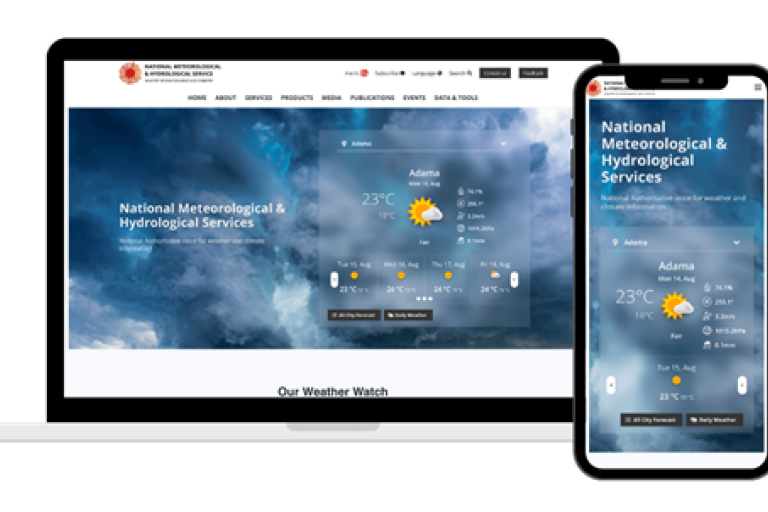A Cutting-Edge Website Template for Weather and Climate Services in Africa
A new Content Management System (CMS) website template developed by the WMO Regional Office for Africa holds the key to the digital transformation of National Meteorological and Hydrological Services (NMHSs) across the African continent.

A new Content Management System (CMS) website template developed by the WMO Regional Office for Africa holds the key to the digital transformation of National Meteorological and Hydrological Services (NMHSs) across the African continent. The modern CMS web template has tools for seamless marketing integrations and for advanced interactive climate data visualization to personalize user experiences as well as a Common Alerting Protocol (CAP) editor. As climate change and extreme weather events intensify, the demand for timely and precise early warnings has never been more critical, thus, interactive weather and climate websites are increasingly important communication tool for NMHSs to deliver localized information and services tailored to user needs.
Early warnings and communications from NMHSs are central to disaster preparedness and a robust online presence can empower the public and bolster their trust in NMHSs. However, many African services face challenges in establishing specialized websites as existing solutions often miss the unique needs of weather and climate services. Within the strategy of digital transformation of NMHSs in Africa, the Regional Office for Africa developed the CMS website template to fill this gap.
The CMS website template contains a set of tools and functionalities that facilitate the delivery of climate services and the communication of early warnings. It allows for a better presentation of products and services and contains tools that are expected to advance the communication of Early Warnings such as an easy-to-use CAP editor, advanced geo-referenced visualization of forecasts, multi-sectoral products and real-time satellite imagery. The template also contains key marketing integrations to support user growth and engagement. This includes advanced video conferencing, e-mail and social media marketing integrations, a dashboard with user analytics and online survey templates to facilitate the collection and analysis of user feedback and co-production of climate services. The interface with aggregated user analytics is expected to improve user management and advance the tailoring of services. The website template is designed to optimize the workflows of NMHSs.
The CMS website template will make critical contributions to the Early Warnings for All initiative:
- The integrated CAP editor ensures that early warnings are easily activated and disseminated in a format that is easily understood by the public and accessible for integration with other dissemination channels. This ensures that vital information reaches citizens in a timely and comprehensible manner, allowing them to take necessary precautions.
- Advanced geo-referenced visualization tools provide real-time updates on impending weather events and their potential impact, to support the transition from “what the weather will be” to “what the weather will do”. This feature allows users to visually track the progression of weather events and climate trends that can inform their decisions.
- Access to real-time satellite imagery ensures that users receive the most up-to-date information on weather patterns, enhancing the accuracy and reliability of early warnings.
Several features were developed in the template to ensure user engagement and to tailor services:
- Integrated marketing tools ensure better business decisions based on the latest user trends.
- The system allows the NMHSs to make their own products, warnings and risk information accessible in various national languages.
- Online survey templates are incorporated to streamline the collection and analysis of user feedback, ensuring that services are continually refined based on user needs.
Built on open-source standards, the CMS template promises to bring about the digital evolution of African NMHSs and a key contribution to the implementation of the recently launched Early Warning for All Action Plan for Africa. Its piloting, officially initialized in August 2023, will witness the installation, customization, training and documentation of the CMS and its components in Benin, Burkina Faso, Ethiopia, Ghana, Malawi, Morocco, Niger, Nigeria, South Sudan, Sudan and Togo, among other countries. The piloting phase will test the CMS features and functionalities with participating WMO Members, smoothly integrating the system into their day-to-day operations. Upon the conclusion of the pilot phase, the valuable insights gained from successful implementations, as well as the challenges faced by participating countries, will be synthesized. These insights will contribute to the development of a stable and optimized version of the CMS in readiness for its operationalization and wider deployment across the continent.
Collaboration between WMO and Norwegian Capacity (NORCAP) has been instrumental in this endeavor. Since August 2022, NORCAP has seconded three of its experts at the WMO Regional Office for Africa. The development of the CMS template results from a combined effort of climate scientists, web developers and innovation specialists. The NORCAP/WMO collaboration will contribute significantly to the WMO-spearheaded UN Secretary-General António Guterres’s initiative to ensure universal access to early warnings in the next five years. WMO extends its gratitude to NORCAP for their unwavering support and expertise.
- Region:
- Region I: Africa

